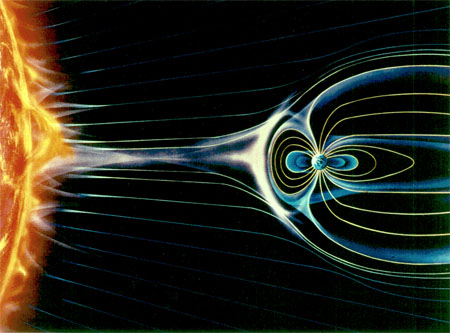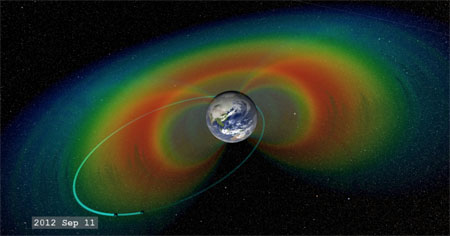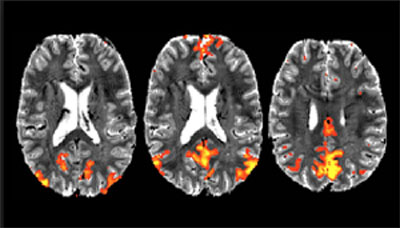Magnetism in Action in the Solar System and on Earth
What happens when a charged particle enters a Magnetic Field
When a charged particle enters an electric field a force is exerted on the charge. What happens when a charged particle enters a magnetic field. There are many factors involved here including the direction in which the charged particle is moving. " if a charged particle moves in the same direction as a magneticed field, no force is eserted on it. If a charged particle moves at an angle to the magnetic field, the magnetic force acting on i will cause it to move in a spiral around the magnetic field lines.
What are the Solar Winds

..."Disturbances in the solar wind shake the Earth's magnetic field and pump energy into the radiation belts. Regions on the surface of the Sun often flare and give off ultraviolet light and x-rays that heat up the Earth's upper atmosphere. This "Space Weather" can change the orbits of satellites and shorten mission lifetimes..." Image from NASA
As previously point out the solar wind is a stream of charged particles mainly a mixture of materials found in the solar plasma, composed primarily of ionized hydrogen (electrons and protons) that emanate from the Sun. These particles move through the solar system at speeds of 300 to 1000 kilometers/second. If the amount of solar radiation released from the sun reched earths surface life as we know it would not be able to exist. These charged particles are however deflected from the Earth' surface by the Earth's magnetic field. With the magnetic field these charged particles would strip away the ozone level which protects the earth from harmful unltraviolet radiation.
How the Earth's Magnetic Field Deflects the Solar Winds
The region in which the Earth's magnetic field is found is called the magnetosphere.
image of bar maget and of magnetosphere. here
If there were no solar winds the force field lines magnetosphere would look much like a bar magnet. However on the side of the earth that faces away from the sun the magnetosphere is blown away into a long tail by the solar winds. The manetosphere constantly changes as the Earth rotates.
What are the Van Allen Belts?
There are times that particles enter into the magnetic fields of the earth. But the particles are still forced to apiral around the magnetic field lines.

Source: The Van Allen Probes (formerly Radiation Belt Storm Probes - RBSP) Explore the Earth's Radiation Belts
These trapped particles move between the north and south poles. These charged particles are generally found in two large areas known as the Van Allen Belt. If these charged particles get too close to the Earth's surface they will interact with atoms in the atmosphere causing release of light. The glowing regions is called an aurora. Auroras are most commonly seen near the poles sine this is the location that the aprticles are closest the Earth's surface. The aurora in the north hemisphere is called the aurora borealis, in the south hemisphere the auroras are referred to as aurora australis.
Magnetorecption - Can Pigeons Sense the Earth's Magnetic Field?
Magnetoreception is a sense which allows an organism to detect a magnetic fields direction, altitude or location. This sensory modality is used by a range of animals for orientation and navigation, and as a method for animals to develop regional maps. For the purpose of navigation, magnetoreception deals with the detection of the Earth's magnetic field. Magnetoreception is present in bacteria, arthropods, molluscs and members of all major taxonomic groups of vertebrates. Humans are not thought to have a magnetic sense -- but a protein cryptochrome---
see Cryptochrome and Magnetic Sensing--
..."The question remains as to where, physically, this radical pair reaction would take place. It has been suggested that the radical pair reaction linked to the avian compass arises in the protein cryptochrome. Cryptochrome is a signaling protein found in a wide variety of plants and animals, and is highly homologous to DNA photolyase. There is some evidence that retinal cryptochromes may be involved in the avian magnetic sense..."see above reference.
Animals such as birds, turtles and even cows appear to be able to detect the earth's magnetic field. Birds can use the earths magnetic to navigate migration This is demonstrated during migration in where bird use the earths magentic field to help in navigation.
An unequivocal demonstration of the use of magnetic fields for orientation within an organism has been in a class of bacteria known as magnetotactic bacteria. These bacteria demonstrate a behavioural phenomenon known as magnetotaxis, in which the bacterium orients itself and migrates in the direction along the Earth's magnetic field lines. The bacteria contain magnetosomes, which are nanometer-sized particles of magnetite or iron sulfide enclosed within the bacterial cells.[3] The magnetosomes are surrounded by a membrane composed of phospholipids and fatty acids and contain at least 20 different proteins [4] They form in chains where the moments of each magnetosome align in parallel, causing each bacterium cell to essentially act as a magnetic dipole, giving the bacteria their permanent-magnet characteristics.
For animals the mechanism for magnetoreception is unknown, but there exist two main hypotheses to explain the phenomenon. According to one model, cryptochrome, when exposed to blue light, becomes activated to form a pair of radicals[6][7] (molecules with a single unpaired electron) where the spins of the two unpaired electrons are correlated. The surrounding magnetic field affects the dynamics of this correlation (parallel or anti-parallel), and this in turn affects the length of time cryptochrome stays in its activated state. Activation of cryptochrome may affect the light-sensitivity of retinal neurons, with the overall result that the bird can see the color phase shift caused by the magnetic field. The Earth's magnetic field is only 0.5 Gauss and so it is difficult to conceive of a mechanism, other than phase shift, by which such a field could lead to any chemical changes other than those affecting the weak magnetic fields between radical pairs. Cryptochromes are therefore thought to be essential for the light-dependent ability of the fruit fly Drosophila melanogaster to sense magnetic fields.
The second proposed model for magnetoreception relies on Fe3O4, also referred to as iron (II, III) oxide or magnetite, a natural oxide with strong magnetism. Iron (II, III) oxide remains permanently magnetized when its length is larger than 50 nm and becomes magnetized when exposed to a magnetic field if its length is less than 50 nm. In both of these situations the Earth's magnetic field leads to a transducible signal via a physical effect on this magnetically sensitive oxide. (Source: Wikipedia)
See also: Cryptochrome protein helps birds navigate via magnetic field
There have been two mechanisms implicated in homing pigeon magnetoreception : the visually mediated free-radical pair mechanism and a magnetite based directional compass or inclination compass. More recent behavioral tests have shown that pigeons are able to detect magnetic anomalies of 186 microtesla (1.86 Gauss).(wikipedia)
Study sheds light on How Birds Navigate by Magnetic Fields
Neural Correlates of a Magnetic Sense
Abstract: "...Abstract
Many animals rely on the Earth's magnetic field for spatial orientation and navigation. However, how the brain receives and interprets magnetic field information is unknown. Support for the existence of magnetic receptors in the vertebrate retina, beak, nose, and inner ear has been proposed and immediate gene expression markers have identified several brain regions activated by magnetic stimulation, but the central neural mechanisms underlying magnetoreception remain unknown. Here, we describe neuronal responses in the pigeon's brainstem that show how single cells encode magnetic field direction, intensity, and polarity—qualities that are necessary to derive an internal model representing directional heading and geosurface location. Our findings demonstrate a neural substrate for a vertebrate magnetic sense..."
..Wu and Dickman have found cells in the pigeon brain that are tuned to specific directions of the magnetic field."..
They identified a group of cells in the brainstem of pigeons that record both the direction and the strength of the magnetic field. And they have good, but not conclusive, evidence to suggest that the information these cells are recording is coming from the bird's inner ear. Dr. Dickman said this research "is still something we want to pursue."
A magnetic protein biocompass - Nature Materials full article here...The notion that animals can detect the Earth's magnetic field was once ridiculed, but is now well established. Yet thebiological nature of such magnetosensing phenomenon remains unknown. Here, we report a putative magnetic receptor(Drosophila CG8198, here named MagR) and a multimeric magnetosensing rod-like protein complex, identified by theoreticalpostulation and genome-wide screening, and validated with cellular, biochemical, structural and biophysical methods.The magnetosensing complex consists of the identified putative magnetoreceptor and known magnetoreception-relatedphotoreceptor cryptochromes (Cry), has the attributes of both Cry- and iron-based systems, and exhibits spontaneousalignment in magnetic fields, including that of the Earth. Such a protein complex may form the basis of magnetoreceptionin animals, and may lead to applications across multiple fields
Biomagnetism
Biomagnetism is the phenomenon where magnetic fields are produced by the living things, especially by the human body; (different from magnetic fields applied to the body, called magnetobiology). The body's magnetic fields are very weak, and are measured with the sensitive detector called a SQUID (superconducting quantum interference device), usually in a magnetically shielded room, which excludes most external disturbances. Thus, Biomagnetism is a promising new window into the human body generally, and into the brain, in particular.
Magnetic Resonance Imaging
How does it work.. from nih source below--- MRIs employ powerful magnets which produce a strong magnetic field that forces protons in the body to align with that field. When a radiofrequency current is then pulsed through the patient, the protons are stimulated, and spin out of equilibrium, straining against the pull of the magnetic field. When the radiofrequency field is turned off, the MRI sensors are able to detect the energy released as the protons realign with the magnetic field. The time it takes for the protons to realign with the magnetic field, as well as the amount of energy released, changes depending on the environment and the chemical nature of the molecules. Physicians are able to tell the difference between various types of tissues based on these magnetic properties.

Source: NIH Magnetic Resonance Imaging
Human Connectome Project - Mapping the human brain is one of the great scientific challenges of the 21st century. The Human Connectome Project (HCP) is tackling a key aspect of this challenge by elucidating the neural pathways that underlie brain function and behavior.
Electricity, Magnetism and Electromagnetism
- Electricity and Magnetism Home
- Electric Charge
- Coulombs Law and Inverse Square Law
- Static Electricity
- The Flow of Electricity
- Electric Current
- Electric Circuits
- Electric Power
- The Nature of Magnets
- Earth as a Magnet
- Magnetism in Action
- Magnetism from Electricity
- Electricity from Magnetism
- How do Transformers Work?
- Ohms Law Lab
- Magnetic Forces Lab
- Why Metals Conduct Electricity
- How does a Battery Work
- How does an Electric Motor Work
Science of Fluids
- Science of Fluids
- What are Fluids?
- What is Pressure?
- What is Hydrostatic Pressure?
- Surface Tension and Capillary Action
- Pascals Principle
- Archimedes Principle
- What is Viscosity?
- Bernouili's Principle